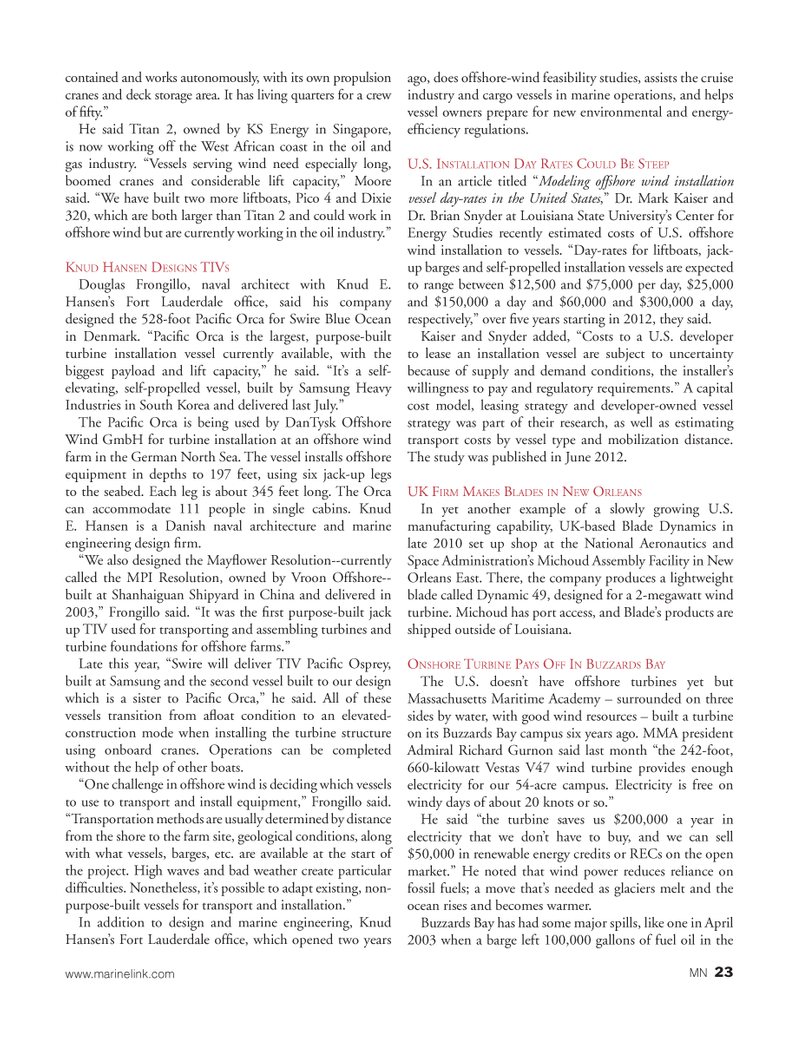
Page 23: of Marine News Magazine (December 2012)
Innovative Products &
Read this page in Pdf, Flash or Html5 edition of December 2012 Marine News Magazine
contained and works autonomously, with its own propulsion cranes and deck storage area. It has living quarters for a crew of Þ fty.Ó He said Titan 2, owned by KS Energy in Singapore, is now working off the West African coast in the oil and gas industry. ÒVessels serving wind need especially long, boomed cranes and considerable lift capacity,Ó Moore said. ÒWe have built two more liftboats, Pico 4 and Dixie 320, which are both larger than Titan 2 and could work in offshore wind but are currently working in the oil industry.Ó KNUD HANSEN DESIGNS TIVSDouglas Frongillo, naval architect with Knud E. HansenÕs Fort Lauderdale ofÞ ce, said his company designed the 528-foot PaciÞ c Orca for Swire Blue Ocean in Denmark. ÒPaciÞ c Orca is the largest, purpose-built turbine installation vessel currently available, with the biggest payload and lift capacity,Ó he said. ÒItÕs a self- elevating, self-propelled vessel, built by Samsung Heavy Industries in South Korea and delivered last July.Ó The PaciÞ c Orca is being used by DanTysk Offshore Wind GmbH for turbine installation at an offshore wind farm in the German North Sea. The vessel installs offshore equipment in depths to 197 feet, using six jack-up legs to the seabed. Each leg is about 345 feet long. The Orca can accommodate 111 people in single cabins. Knud E. Hansen is a Danish naval architecture and marine engineering design Þ rm.ÒWe also designed the Mayß ower Resolution--currently called the MPI Resolution, owned by Vroon Offshore-- built at Shanhaiguan Shipyard in China and delivered in 2003,Ó Frongillo said. ÒIt was the Þ rst purpose-built jack up TIV used for transporting and assembling turbines and turbine foundations for offshore farms.Ó Late this year, ÒSwire will deliver TIV PaciÞ c Osprey, built at Samsung and the second vessel built to our design which is a sister to PaciÞ c Orca,Ó he said. All of these vessels transition from aß oat condition to an elevated- construction mode when installing the turbine structure using onboard cranes. Operations can be completed without the help of other boats.ÒOne challenge in offshore wind is deciding which vessels to use to transport and install equipment,Ó Frongillo said. ÒTransportation methods are usually determined by distance from the shore to the farm site, geological conditions, along with what vessels, barges, etc. are available at the start of the project. High waves and bad weather create particular difÞ culties. Nonetheless, itÕs possible to adapt existing, non- purpose-built vessels for transport and installation.Ó In addition to design and marine engineering, Knud HansenÕs Fort Lauderdale ofÞ ce, which opened two years ago, does offshore-wind feasibility studies, assists the cruise industry and cargo vessels in marine operations, and helps vessel owners prepare for new environmental and energy- efÞ ciency regulations. U.S. INSTALLATION DAY RATES COULD BE STEEPIn an article titled Ò Modeling offshore wind installation vessel day-rates in the United States ,Ó Dr. Mark Kaiser and Dr. Brian Snyder at Louisiana State UniversityÕs Center for Energy Studies recently estimated costs of U.S. offshore wind installation to vessels. ÒDay-rates for liftboats, jack- up barges and self-propelled installation vessels are expected to range between $12,500 and $75,000 per day, $25,000 and $150,000 a day and $60,000 and $300,000 a day, respectively,Ó over Þ ve years starting in 2012, they said. Kaiser and Snyder added, ÒCosts to a U.S. developer to lease an installation vessel are subject to uncertainty because of supply and demand conditions, the installerÕs willingness to pay and regulatory requirements.Ó A capital cost model, leasing strategy and developer-owned vessel strategy was part of their research, as well as estimating transport costs by vessel type and mobilization distance. The study was published in June 2012. UK FIRM MAKES BLADES IN NEW ORLEANSIn yet another example of a slowly growing U.S. manufacturing capability, UK-based Blade Dynamics in late 2010 set up shop at the National Aeronautics and Space AdministrationÕs Michoud Assembly Facility in New Orleans East. There, the company produces a lightweight blade called Dynamic 49, designed for a 2-megawatt wind turbine. Michoud has port access, and BladeÕs products are shipped outside of Louisiana.ONSHORE TURBINE PAYS OFF IN BUZZARDS BAY The U.S. doesnÕt have offshore turbines yet but Massachusetts Maritime Academy Ð surrounded on three sides by water, with good wind resources Ð built a turbine on its Buzzards Bay campus six years ago. MMA president Admiral Richard Gurnon said last month Òthe 242-foot, 660-kilowatt Vestas V47 wind turbine provides enough electricity for our 54-acre campus. Electricity is free on windy days of about 20 knots or so.Ó He said Òthe turbine saves us $200,000 a year in electricity that we donÕt have to buy, and we can sell $50,000 in renewable energy credits or RECs on the open market.Ó He noted that wind power reduces reliance on fossil fuels; a move thatÕs needed as glaciers melt and the ocean rises and becomes warmer. Buzzards Bay has had some major spills, like one in April 2003 when a barge left 100,000 gallons of fuel oil in the www.marinelink.com MN 23

 22
22

 24
24
